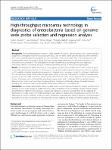High-throughput microarray technology in diagnostics of enterobacteria based on genome-wide probe selection and regression analysis
Friedrich, Torben
Rahmann, Sven
Weigel, Wilfried
Rabsch, Wolfgang
Fruth, Angelika
Ron, Eliora
Gunzer, Florian
Dandekar, Thomas
Hacker, Jörg
Müller, Tobias
Dobrindt, Ulrich
Background: The Enterobacteriaceae comprise a large number of clinically relevant species with several individual subspecies. Overlapping virulence-associated gene pools and the high overall genome plasticity often interferes with correct enterobacterial strain typing and risk assessment. Array technology offers a fast, reproducible and standardisable means for bacterial typing and thus provides many advantages for bacterial diagnostics, risk assessment and surveillance. The development of highly discriminative broad-range microbial diagnostic microarrays remains a challenge, because of marked genome plasticity of many bacterial pathogens. Results: We developed a DNA microarray for strain typing and detection of major antimicrobial resistance genes of clinically relevant enterobacteria. For this purpose, we applied a global genome-wide probe selection strategy on 32 available complete enterobacterial genomes combined with a regression model for pathogen classification. The discriminative power of the probe set was further tested in silico on 15 additional complete enterobacterial genome sequences. DNA microarrays based on the selected probes were used to type 92 clinical enterobacterial isolates. Phenotypic tests confirmed the array-based typing results and corroborate that the selected probes allowed correct typing and prediction of major antibiotic resistances of clinically relevant Enterobacteriaceae, including the subspecies level, e.g. the reliable distinction of different E. coli pathotypes. Conclusions: Our results demonstrate that the global probe selection approach based on longest common factor statistics as well as the design of a DNA microarray with a restricted set of discriminative probes enables robust discrimination of different enterobacterial variants and represents a proof of concept that can be adopted for diagnostics of a wide range of microbial pathogens. Our approach circumvents misclassifications arising from the application of virulence markers, which are highly affected by horizontal gene transfer. Moreover, a broad range of pathogens have been covered by an efficient probe set size enabling the design of high-throughput diagnostics.
Dateien zu dieser Publikation
Keine Lizenzangabe
Verwandte Publikationen
Anzeige der Publikationen mit ähnlichem Titel, Autor, Urheber und Thema.
-
2013-07-12ZeitschriftenartikelDNA Uptake by the Nosocomial Pathogen Acinetobacter baumannii Occurs during Movement along Wet Surfaces Wilharm, Gottfried; Piesker, Janett; Laue, Michael; Skiebe, EvelynThe emergence of Acinetobacter baumannii as an increasingly multidrug-resistant nosocomial pathogen largely relies on acquisition of resistance genes via horizontal gene transfer. Here, we demonstrate that many clinical ...
-
2015-04-01ZeitschriftenartikelCapsules, Toxins and AtxA as Virulence Factors of Emerging Bacillus cereus Biovar anthracis Brézillon, Christophe; Haustant, Michel; Dupke, Susann; Corre, Jean-Philippe; Lander, Angelika; Franz, Tatjana; Monot, Marc; Couture-Tosi, Evelyne; Jouvion, Gregory; Leendertz, Fabian; Grunow, Roland; Mock, Michèle E.; Klee, Silke; Goossens, Pierre L.Emerging B. cereus strains that cause anthrax-like disease have been isolated in Cameroon (CA strain) and Côte d’Ivoire (CI strain). These strains are unusual, because their genomic characterisation shows that they belong ...
-
2011-09-08ZeitschriftenartikelRare Occurrence of Methicillin-Resistant Staphylococcus aureus CC130 with a Novel mecA Homologue in Humans in Germany Cuny, Christiane; Layer, Franziska; Strommenger, Birgit; Witte, WolfgangMRSA CC130 containing the mecA homologue mecALGA251 were reported from the UK and from Denmark so far from cattle and humans. Here we report on 11 MRSA CC130 among a sample of 12691 isolates of human origin collected from ...

